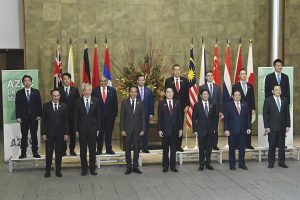The final month of 2023 saw the ASEAN-Japan Commemorative Summit held in Tokyo. Because of the military coup in Myanmar in February 2021 and the subsequent turmoil, Myanmar did not participate, but all nine other leaders attended, as did ASEAN Secretary-General Kao Kim Hourn and Prime Minister Xanana Gusmão from Timor-Leste, which has been officially approved for ASEAN membership and which was taking part as an observer. After the conclusion of the summit, co-chaired by Prime Minister Kishida Fumio and Prime Minister Joko Widodo of Indonesia, holder of the 2023 presidency, a Joint Vision Statement on Japan-ASEAN friendship and cooperation was announced, along with an implementation plan with specific areas of cooperation.
The statement is the successor to the raft of documents about the Japan-ASEAN partnership and cooperation that have been presented at key occasions in the relationship, including the Tokyo Declaration adopted at the first Japan-ASEAN Commemorative Summit from December 2003, the Bali Statement from 2011, and the Vision Statement from 2013. This latest Vision Statement identifies three pillars for future partnership: Heart-to-Heart Partners across Generations, Partners for Co-creation of Economy and Society of the Future, and Partners for Peace and Stability. Including these pillars, the statement does not in principle deviate markedly from the direction hitherto taken. However, in light of changes in the regional order and the transformation of Japan-ASEAN relations, some policy changes have been made.
First, the statement clarifies a vision for ASEAN and Japan as well as shared principles and values that should form the basis for that vision. It is noteworthy that these shared principles and values explicitly include not only respect for sovereignty and other traditional ASEAN norms as stipulated in the Treaty of Amity and Cooperation in Southeast Asia, maintaining and strengthening ASEAN unity and centrality, and making the ASEAN Outlook on the Indo-Pacific mainstream, but also the principles of democracy, rule of law and good governance, as well as respect for and the protection of human rights. It is not that previous Japan-ASEAN documents did not mention democracy and human rights, but they were much more reserved, for instance limiting democracy and human rights to items under one of the pillars.
Both ASEAN and Japan face issues related to democracy and human rights. This time in particular, there is growing interest in the Myanmar issue, both domestically and internationally. As such, it is thought that the aim was to signal to publics at home and abroad that the interlocutors are aware of the importance of these domestic political issues.
One change is a clearer policy of advancing cooperation regarding traditional security, referring to cooperation in connection with security and politics included in the third pillar, Partners for Peace and Stability. In previous statements and declarations, ASEAN and Japan touched on security cooperation, but that consisted of items falling under non-traditional security cooperation such as dialogue and cooperation through the ASEAN architecture, problem-solving through compliance with international law, and anti-piracy measures. In addition to non-traditional security cooperation, the new statement mentioned “strengthening security cooperation, including maritime security cooperation” as the first concrete item under the third pillar, emphasizing maritime security. The implementation plan also stipulates strengthening cooperation between the countries with maritime law enforcement agencies, supporting the strengthening maritime security capabilities, and cooperating in defense matters under the ASEAN-Japan Defense Cooperation Initiative. In other words, the new Vision Statement suggests a policy of promoting cooperation that can directly contribute to regional stability and peace.
The second pillar, Partners for Co-creation of Economy and Society of the Future, encompasses supporting the ASEAN community, quality infrastructure, smart cities, supporting micro-, small-, and medium-sized enterprises (MSMEs) and start-ups, public health, healthcare and welfare, supply chain resilience, facilitating trade and investment, finance, energy, climate change, humanitarian assistance and disaster relief, digitalization, agricultural security and food security, the working environments of foreign workers, protecting and empowering people in vulnerable groups, strategic development cooperation including Official Development Assistance (ODA), and other means. The implementation plan is even more specific, a reflection of the fact that cooperation aimed at economic development and that aimed at building a better society were traditionally seen as distinct.
This is significant. Excessive globalization spearheaded by neoliberalism has been criticized for creating widening inequality, deteriorating human rights for workers, and destroying the environmental, making not only economic growth but also sustainability and social fairness important issues. ASEAN societies have also matured, albeit to varying degrees, so they are not insensitive to these issues as the middle class expands and civil society grows. Each country’s growth strategy must also consider development toward a sustainable and just society. So this second pillar can be interpreted as a response to changes in the circumstances surrounding Japan and ASEAN as well as changes in awareness associated with the maturing of societies.
The foremost pillar in this year’s Vision Statement is “Heart-to-Heart Partners across Generations,” which calls for mutual understanding and trust-building. This is an expression of the belief that mutual understanding and trust-building between the peoples of ASEAN and Japan constitute the foundation for realizing a prosperous, sustainable, and just economy and society, and that a peaceful and stable regional order can be maintained on top of that foundation. It reflects the shrinking of human networks between ASEAN and Japan, necessitating the rebuilding of multi-layered, pluralistic human networks in new ways, especially among younger generations.
The course has been set. The question is how to implement and advance the various forms of cooperation outlined in the Vision Statement and implementation plan, and how to make the vision a reality. The truly pivotal moment in the Japan-ASEAN partnership is yet to come.

































